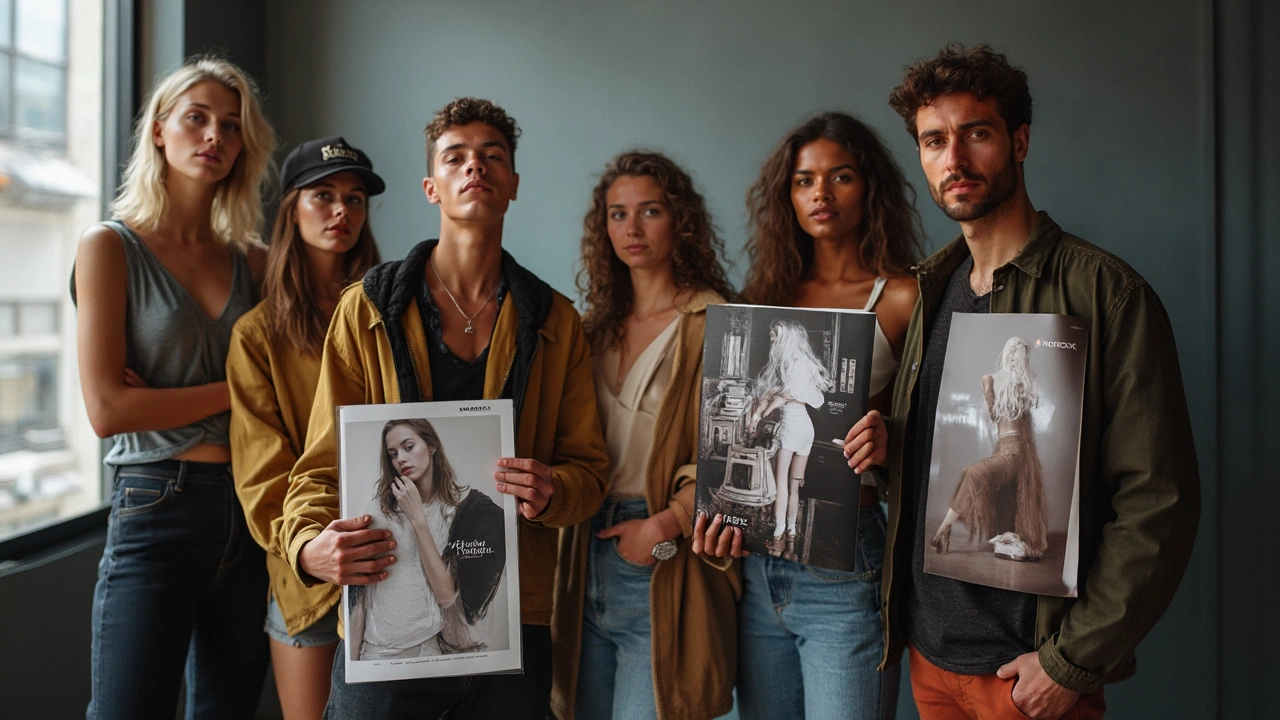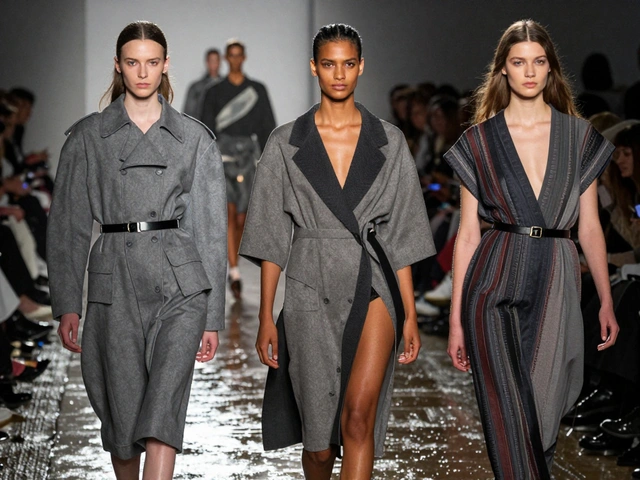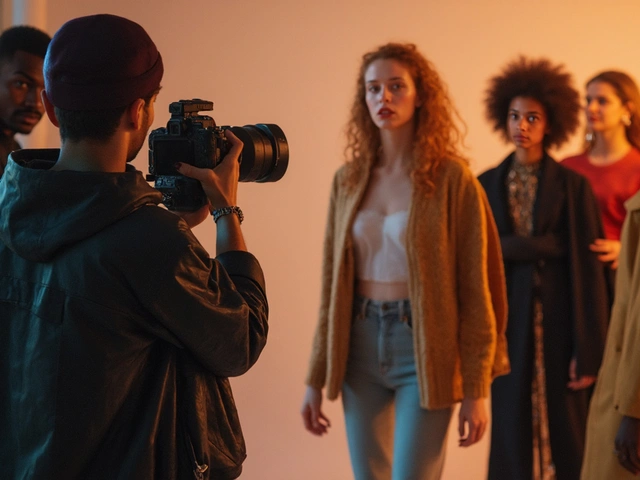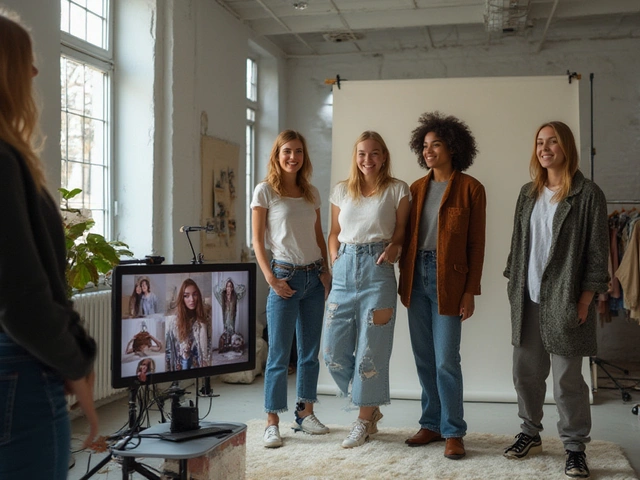Trying to make your mark as a model but keep hearing you need a 'dynamic' portfolio? Here’s what that actually means: your book can't just have a few good shots. It needs to tell a story about who you are and what you can do. If you play it safe with boring, nearly identical photos, agents scroll right by. But a mix of looks, styles, and energy? That’s what gets callbacks.
Your portfolio isn’t just proof you’ve been in front of a camera. Think of it as your highlight reel. Agencies want to see variety—headshots to show your natural vibe, full-body shots for movement, maybe a strong editorial shot for attitude. Every picture should say, ‘This person can handle different gigs.’
- Why Dynamic Portfolios Get You Noticed
- Choosing Photos That Show Your Range
- Smart Photographer Picks
- Preparing for Your Shoot
- Portfolio Updates That Keep You Relevant
- Common Mistakes and Easy Fixes
Why Dynamic Portfolios Get You Noticed
If you wonder why some models get selected over others, a huge part of the answer is their model portfolio. Agencies often look through hundreds of portfolios a week. If yours looks just like everyone else’s, odds are you’ll be skipped. But when your portfolio shows you can pull off different looks—like casual, high fashion, commercial, and fitness—all in one place, you instantly stand out.
Numbers speak for themselves. According to a 2023 survey by The Model Alliance, 78% of agencies said they favor models with versatile portfolios over those with just a single style or pose. If you can look comfortable in both streetwear and sleek eveningwear, you open the door to more jobs and make yourself more appealing to a broader range of clients.
| Element | Why it Matters |
|---|---|
| Headshots | Shows your real face and expressions |
| Full-body shots | Gives clients a view of your proportions and movement |
| Editorial shots | Demonstrates creativity and presence |
| Commercial shots | Appeals to brand clients (e.g., catalog or lifestyle) |
A dynamic portfolio also tells agencies you’re serious. It shows you’ve put thought into your presentation instead of dumping every photo you own into your book. You might not realize, but some top agencies, like IMG, mention that new faces with variety in their portfolio get a callback rate 25% higher than those with generic, one-note books.
Here’s what dynamic models usually do differently:
- They use a mix of outfits, backgrounds, and expressions
- They show they can move comfortably in front of the camera
- They avoid old, out-of-date styles or “selfie” shots
- They keep their portfolio focused—no filler, just their best
If you’re aiming for more castings and bigger clients, don’t sleep on making your portfolio as dynamic as possible. This single move could change how many doors open up for you.
Choosing Photos That Show Your Range
If there’s one thing that makes portfolio shots stand out, it’s showing range. Agents and clients want to know if you can nail different vibes, not just one look you like. It’s kind of wild—data from several U.S. model agencies in 2024 says every portfolio that gets tapped for callbacks showcases at least three solid, different styles. That’s not a coincidence.
No matter your niche—commercial, editorial, fitness, or high fashion—having a model portfolio that covers the bases makes you way more marketable. You want to prove you can do more than look good in great lighting. Show you can adapt.
- Headshots: Natural light, minimal makeup. This one is all about your clean look. Smile in one, give a serious look in another.
- Full body: Use neutral or solid colors so the focus is you, not your outfit. Include standing and sitting poses for variety.
- Editorial shot: Something with more mood—think a strong pose, different lighting, or fashion-forward outfit. This is where you can get creative.
- Lifestyle/image: These shots show you in a relatable setting, like grabbing coffee, laughing, or walking around a city. Real brands dig these, especially for online ads.
- Movement/action: Whether you jump, run, or just move naturally, this tells clients how you handle motion and direction.
But don’t overload your book—6 to 12 images is plenty for most agencies. It’s quality over quantity. A bunch of nearly identical shots screams amateur. You want each photo to look different and say something unique.
| Photo Type | Recommended Number |
|---|---|
| Headshots | 2 |
| Full Body | 2 |
| Editorial/Fashion | 2 |
| Lifestyle | 2 |
| Movement/Action | 1-2 |
Here’s a quick tip: Swap out images every season or after you do something new. If you land a branded shoot or an editorial with a cool theme, work it in. The pros keep it fresh because new work means new opportunities.
Smart Photographer Picks
Not every photographer knows how to shoot a strong model portfolio. It’s tempting to go with the cheapest option or let your friend who just got a camera snap a few pics. But that’s how you end up with amateur shots that don’t impress anyone.
Look for photographers who have clear experience shooting for models, portfolios, or agencies. The easiest way? Check their Instagram or website—do their images look like the ones you see in real agency books? You don’t want someone who only shoots weddings or animals. Specialization matters.
Here’s what else to check before booking:
- Portfolio Quality: Are their images sharp, natural, and well-lit? Avoid anyone whose shots look heavily filtered or airbrushed.
- Client Reviews: See if past models mention working comfortably and getting usable shots.
- Turnaround Time: Some photographers deliver proofs in days; others take weeks. Ask before you commit if you need pics fast.
- Cost vs. Value: Higher price doesn’t always mean better quality but be wary if someone greatly undercharges—sometimes you get what you pay for.
Want evidence of how important the right photographer is? The British Journal of Photography found that agencies accept only 25-30% of first-time model submissions with amateur photos, but the number jumps to over 60% when models use professional portfolio shots. That’s a big difference for your odds.
| Photographer Type | Chance Portfolio Gets Priority Review |
|---|---|
| Amateur/Family Friend | 15% |
| Student Photographer | 30% |
| Professional Model Portfolio Photographer | 65% |
If you’re not in a major city, look for traveling photographers or consider a weekend trip. You want someone who knows the difference between a simple headshot and a showstopper image that fits agency standards. A little research means your portfolio gets taken seriously right from the start.
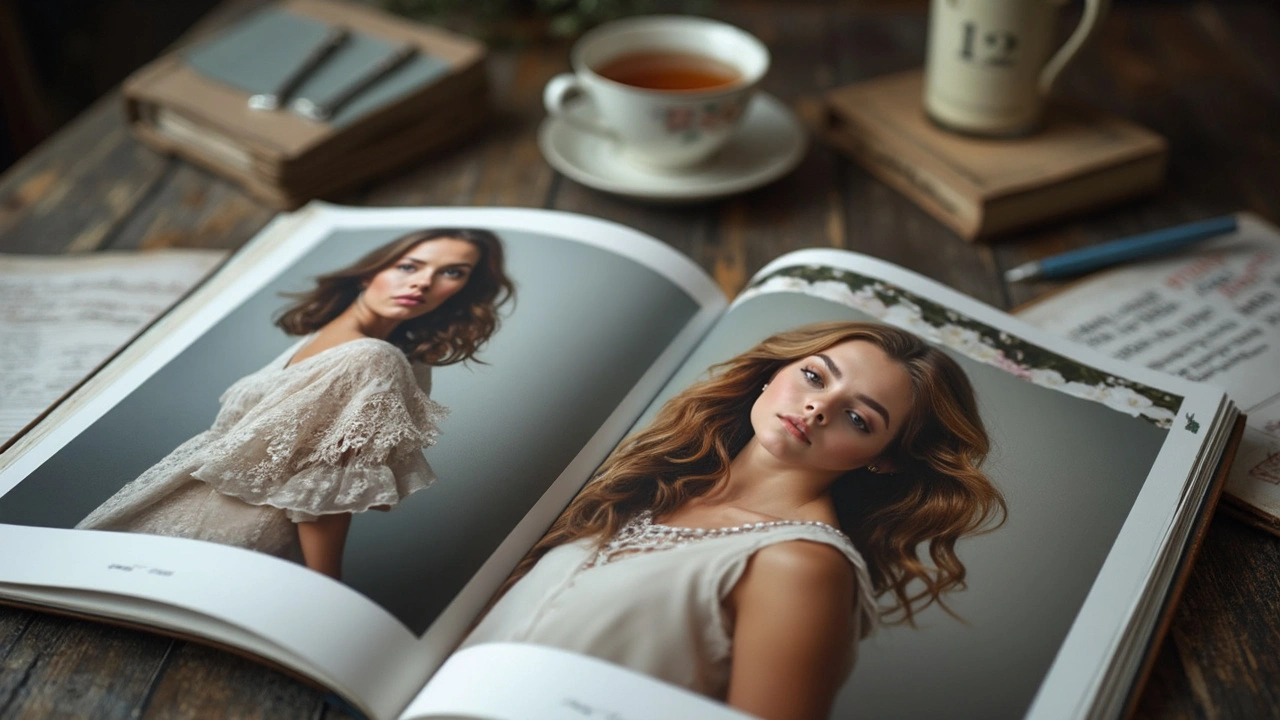
Preparing for Your Shoot
No matter how comfortable you are in front of the camera, planning makes all the difference. Models who come prepared get better shots, period. There’s no substitute for knowing what works for you, what you want to show, and how to keep things running smooth on shoot day.
Think about your model portfolio as a puzzle; every piece should fit. Before you even walk on set, firm up these four things:
- Wardrobe Variety: Bring more options than you think you'll need. Simple, fitted clothes in solid colors always work. Avoid huge logos—they’re distracting and hard for retouchers. Jeans, a clean white T-shirt, and at least one standout look (like a bold jacket or cool boots) cover almost any base.
- Skin & Hair: Show up with clean skin and washed hair. Leave heavy makeup and complex hairstyles at home unless you got a glam shot planned. Most agencies and clients want to see your real features. And yes, drink plenty of water the day before—it genuinely helps with skin glow.
- Reference Shots: Save some sample poses or photos on your phone that match what you want for your book. Photographers appreciate knowing what you’re aiming for. Plus, it keeps everyone on the same page, literally.
- Rest and Fuel: Get at least seven hours of sleep the night before. Tired eyes show up on high-res cameras—no filter can fix that. Eat a light breakfast; nobody wants to pose hangry.
Small things slip through the cracks, so make a checklist the night before. Here’s what most working models bring:
- Basic makeup kit
- Brush/comb and hair ties
- Black and nude underwear
- Snacks and water
- Heels, flats, and sneakers (if your portfolio shows lifestyle and fashion shots)
Not sure how much time to schedule? Plan for about 2-3 hours per outfit or look. That covers changing, lighting setups, quick makeup tweaks, and a breather between shots.
| Essentials | Why |
|---|---|
| Wardrobe Options | Covers different looks; avoid duplicates |
| Makeup Kit | Quick touch-ups as needed |
| Skin & Hair Prepped | Natural look; easier for retouching |
| Reference Shots | Keep creative direction on track |
| Rest | Bright, energetic appearance |
| Water & Snacks | Avoid drops in energy |
Here’s a pro tip: talk with your photographer before the shoot. Share your outfit ideas and ask if they have a makeup artist or stylist lined up. Some photographers bring their own vision—make sure it lines up with what you want in your portfolio. Good communication can save you time, frustration, and let you walk away with photos you’re actually proud to show.
Portfolio Updates That Keep You Relevant
Modeling trends move fast—one month, everyone wants a classic beauty, the next it’s all about edgy street style. If you want agents and clients to pay attention, keeping your portfolio fresh is non-negotiable. Every three to six months, grab your images and check: do your photos match what’s in demand right now?
If your look’s changed, update your photos ASAP. Agencies get frustrated seeing older shots where you look totally different. Hair color, tattoos, even your personal style—these all matter. A recent poll by Models.com found that over 60% of agents skip on models whose portfolios look outdated (think: obvious seasonal trends or missing current hair).
- Sort your images by date and style. Remove anything that feels tired or no longer shows your best side.
- Add at least one photo from a recent job, test shoot, or collaboration each quarter. Show that you’re working and adaptable.
- If you’re trying out for a special job (like fitness or commercial modeling), add photos that match what they’re looking for.
- Change your main headshot when you make a big change—cutting your hair, getting visible tattoos, or changing your look in a dramatic way.
Use your stronger, most current work to push weaker or older photos out, even if you feel sentimental about them. The most important thing is that your model portfolio makes you look right for today, not last year. Agencies are on social media all the time, scouting new looks—if you haven’t done an update in months, that’s a missed shot to stand out.
Common Mistakes and Easy Fixes
Way too many new models trip up on simple stuff that can totally mess up their model portfolio. Not fixing these mistakes can cost you real gigs or even stop you from getting noticed in the first place.
First big blunder? Overediting. If your skin looks like plastic or your eyes are literally glowing, agents will just think, 'Wow, what are they hiding?' A top NY model scout once said,
"Agencies want to see the real you. If we spot heavy Photoshop, it goes straight into the 'no' pile."
Here are the most common mistakes—and what to do instead:
- Repeating the same look. Five shots in the same outfit and pose isn’t range. Add variety: clothes, expressions, angles.
- Low-quality images. Blurry, dark, or pixelated pics—even if you love the vibe, they scream amateur. Use photos from skilled photographers with good lighting.
- Forgetting updates. If you changed your look (got bangs, switched hair color), update your book ASAP. Old photos mess with expectations at castings.
- Ignoring feedback. Sometimes you’re too close to your own photos. Get a mentor or photographer to give real feedback.
- Trying too hard. Wild concepts or heavy makeup can distract from your features. Keep it simple in at least a few shots so your natural look shines through.
Just so you know what clients and agencies are really looking for, check out these stats from a survey done last year by Model Management online:
| Mistake | % of Agents Noticed |
|---|---|
| Photoshopped images | 68% |
| Repeating looks/styles | 54% |
| Old or outdated photos | 46% |
| Unprofessional quality | 74% |
Getting it right isn’t complicated. Here’s what helps:
- Stick to natural retouching—clean up blemishes, but leave the character
- Swap out old shots every few months or after a major look change
- Shoot with more than one photographer to get a range of styles
- Have both a friend and a pro review your photos before choosing
